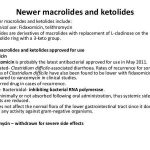
Ceftriaxone (Omnicef) 300mg has been available generically in Europe since 2002. In 2000, Cubist Pharmaceuticals announced that it had acquired the rights to oral ceftriaxone and was developing an alternate oral formulation.

Ketolides are a new class of macrolide derivatives designed specifically to combat macrolide-resistant respiratory tract pathogens. The ketolides exhibit good activity against gram-positive and some gram-negative organisms and have excellent activity against drug-resistant S. pneumoniae, including macrolide-resistant strains. Spontaneous resistance to the available ketolide, telithromycin, is rare. Ketolides display excellent pharmacokinetics that allow once-daily dose administration and extensive tissue distribution relative to serum.

Gatifloxacin has a broad spectrum of activity similar to activity observed in other third-generation fiuoroquinolones. The agent is well absorbed following oral administration (almost 100% bioavailability), and its pharmacodynamic and pharmacokinetic properties (e.g., high volume of distribution, long elimination half-life) allow once-daily administration.

Aminoglycosides are the preferred agents for treating serious infections caused by aerobic gram-negative bacilli. Aminoglycosides play only a minor role in the treatment of community-acquired pneumonia; their use is typically limited to hospitalized patients with severe or complicated community-acquired pneumonia in which gram-negative infections (particularly P. aeruginosa) are suspected.

Glycopeptides are bactericidal antibiotics used principally for treatment of severe gram-positive infections in patients who cannot receive or who have failed to respond to penicillins and cephalosporins. They may also be used in patients suspected of having pathogens resistant to β-lactams and other anti-infectives.

Host defenses such as anatomic, functional, and mechanical barriers serve to protect the intact bronchial tree from invading organisms. Some key factors in the pathophysiology of community-acquired pneumonia are alterations in host defense mechanisms, invasion by virulent microorganisms, and the quantity (i.e., inoculum) of the invading microbes. community-acquired pneumonia is usually acquired by inhalation or aspiration of pulmonary pathogenic organisms into a lung segment or lobe. Much less commonly, community-acquired pneumonia may result from a secondary bacteremia from a distant source — for example, community-acquired pneumonia secondary to Escherichia coli urinary tract infection and/or bacteremia.

The prevalence in the community of bacterial resistance to common antibiotic classes has risen dramatically over the past two to three decades. Pathogens can develop antibiotic resistance through many mechanisms. These mechanisms include production of enzymes that degrade the antibiotic (e.g., β-lactamases), modification of drug targets (e.g., modified penicillin-binding proteins and ribosomes that limit the activity of penicillins and macrolides, respectively), and expression of membrane proteins that pump the antibiotic out of the bacteria.